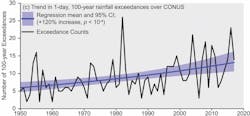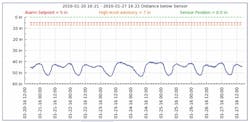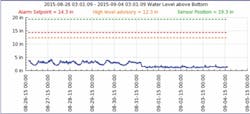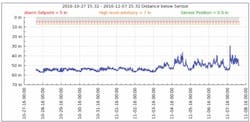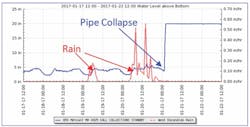About the author:
Greg Quist, Ph.D., is CEO and founder of SmartCover Systems. Quist can be reached at [email protected] and 760.291.1980.
The vast networks of buried water, wastewater and storm water infrastructure are the veins and arteries feeding our people, our cities and protecting our environment. Without sustainable and viable water, waste and storm water solutions, our quality of life is in peril. Society’s water, wastewater and storm water systems have played significant roles in eliminating disease, the safeguarding the environment and protecting communities. Thanks to substantial post-depression and post-World War II investments, most in the U.S. have grown up without the need to give this infrastructure a second thought. We open the taps and a clean, safe and seemingly unlimited supply of water is available to us; our waste is whisked away, treated and returned to the environment; and storm events rarely interrupt our daily lives.
Without attention, this situation is not sustainable. Most water and wastewater infrastructure was installed during the 19th century and now is reaching the end of its useful life. Municipalities are facing the challenge of broad-scale infrastructure replacement at an estimated cost between $300 billion and $1 trillion dollars.
240,000 water mains break annually resulting in the loss of 1.7 trillion gal of drinking water and 900 billion gal of untreated wastewater reaching public waterways due to blockages from cooking fats, root debris, oils and grease (FROG). Sewer spills, or sanitary sewer overflows (SSOs), and wastewater main breaks can have direct and immediate impacts on public health, as well.
For example, in 1989, sewer spills in Cabool, Mo., contaminated drinking water distribution lines, causing 243 cases of diarrhea and four deaths. In 1993, direct contact with a discharge of untreated sewage in Ocoee, Fla., resulted in 39 cases of Hepatitis A.
Complicating matters is the changing climate, which means systems built 30 years ago may not be sufficient to support the extreme weather events of today. Consider peak spring runoff from the snow sheds of the Colorado River basin has advanced, occurring earlier and faster than historic averages. Extreme rainfall events have been increasing in number since 1950, with severities that routinely exceed common engineering design criteria like the 100‐year storm as evidenced by the image below.
These new operating conditions are straining collection systems, which are designed to see slow releases of snowmelt over an extended period of time or occasional weather events like a 100-year storm.
While society has managed to build substantial cities and municipalities on the backs of the infrastructure installed by its grandfathers, the days of reckoning are approaching. It is a slow-motion crash—one that will occur over decades—because this infrastructure cannot be replaced instantaneously.
Addressing these problems means squeezing more out of current infrastructure to maximize utility investments and ensure that even during replacement programs, our cities and their citizens can continue to be protected.
Data Drives Decisions
To extend the life of infrastructure, reliance on smart city technology capabilities is critical. By creating visibility into buried assets to understand the conditions of underground infrastructure, utilities can compare current performance with expectations, and predict when and where problems may arise. Fortunately, with the proliferation of small, rugged, low power sensors combined with reliable communications systems, and the availability of advanced computing capabilities, monitoring real-time performance of systems is feasible. By incorporating external data such as weather and tides, this real-time, predictive, integrated decision support tool provides simple and measurable actions to actively operate and maintain these systems.
Further, as municipalities collect data, they can employ the methods of machine learning to refine and improve the results. As an example, using a small number of sophisticated sensors within a sewer system, patterns of normal and abnormal conditions become apparent. Much like an EKG of human heart rhythms, the pattern can be used to identify specific anomalies within a wastewater collection system. This is particularly true when the data set becomes large enough to apply advanced artificial intelligence tools.
Innovating in Partnership With Utilities Nationwide
SmartCover Systems is working hand-in-hand with wastewater utility leaders across the nation to develop these opportunities, combining robust sensing devices and satellite communication capability with analytics and event notification platforms to provide information about the real-time condition of sewer system. With strategically placed SmartCover remote field units, operators are identifying blockages before they overflow onto the street; detecting storm water infiltration before it overwhelms the defenses; and can locate surging sewers before they back up into homes and businesses.
More than 200 million hours of sewer and storm water monitoring data have been collected, and artificial intelligence (AI) pattern recognition is helping identify common issues with wastewater collection system infrastructure, issues that rarely are evident to operators unless they are “popping a manhole.”
Most importantly, operators are using these tools for real-time decision support as they provide advance warning of potential issues. Not only does this make the operator’s job easier, it offers significant public health benefits by drastically reducing the probability of a sewer spill.
In practice, employing these AI-driven decision support tools has resulted in significant savings for wastewater utilities.
Efficient Operation Through Data Support
The Hawthorne, Calif., utility has two full-time field staff, 90 miles of collections system pipe and more than 2,000 manholes. Its system was experiencing 10 SSOs every year resulting in $400,000 in environmental fines plus clean-up and litigation costs. Reversing this unsustainable situation involved the strategic installation of 50 SmartCover sensors, which reduced SSOs and saved the city more than $2.5 million in fines and mitigation costs over the past 13 years.
Similarly, the San Antonio Water System (SAWS) employed the SmartCover AI-based trend analysis capabilities (SmartTrend) along with 200 remote field units to operate a real-time sewer cleaning optimization program. This program allowed SAWS to strategically identify areas needing cleaning, which has resulted in an overall reduction of cleaning operations. Not only has SAWS eliminated SSOs with this program, it has significantly reduced the wear and tear on its collection system that results from high pressure jetting, allowing existing infrastructure to continue to serve the community well into the future. After just three years, SAWS has saved more than $3.4 million.
Escondido, Calif., used the event management capability of the platform to prevent a significant SSO during an intense rain event occurring as a result of an atmospheric river hitting Southern California. The AI platform identified a flow blockage resulting from a collapsed pipe, triggering an alarm to staff who responded and were able to return the system to operational status well before the potential flooding of a commercial industrial complex took place.
This also was the case in Mount Crested Butte, Colo., a bucolic ski town nestled in the Rocky Mountains with about 6,500 residents. The town had sewer spills in 2005 and 2006, and state regulators threatened to pull operating permits if the problem was not addressed.
Local engineers estimated it would take about $10 million to fix the 10-mile pipe until they learned about SmartCover. When the state indicated it was open to a technology solutions in lieu of a pipeline replacement, Crested Butte engaged SmartCover to provide real-time visibility to its collection system, which often was covered by feet of snow. By applying smart monitors across the collection system for a cost of $96,000, rather than $10 million, the town not only eliminated the spills but saw an immediate return on investment.
Each of these examples demonstrates the power of real-time data, AI-driven pattern recognition and simple, easy decision support tools. By truly understanding the dynamic conditions existing in a sewer system, managers and operators can make more informed, proactive, data-driven decisions to maximize the capacity of existing infrastructure to preserve and protect public health, the environment and quality of life.


